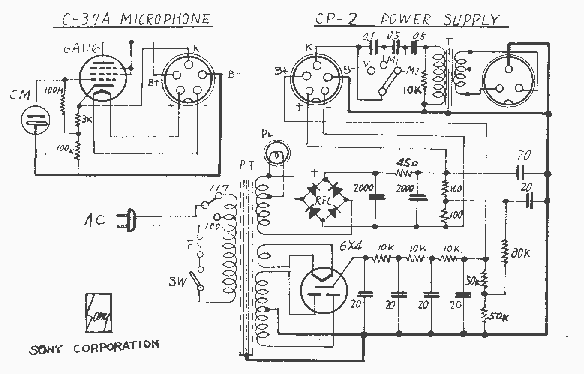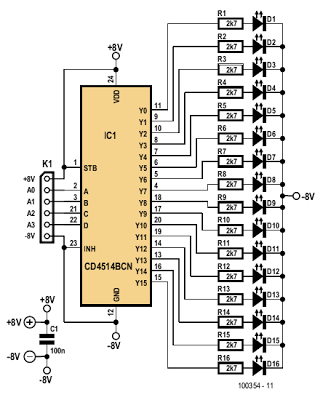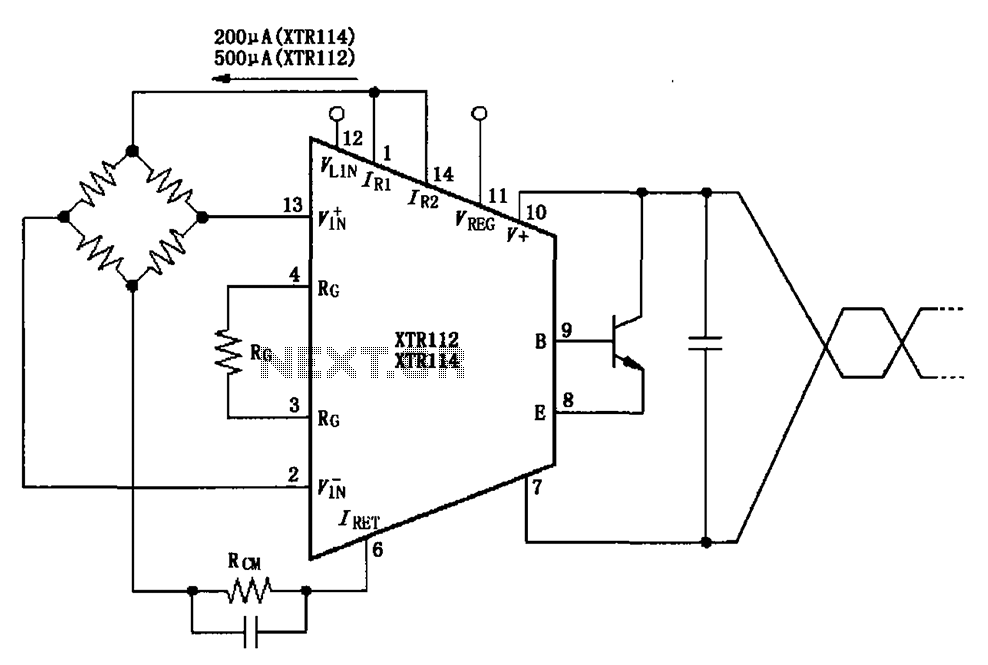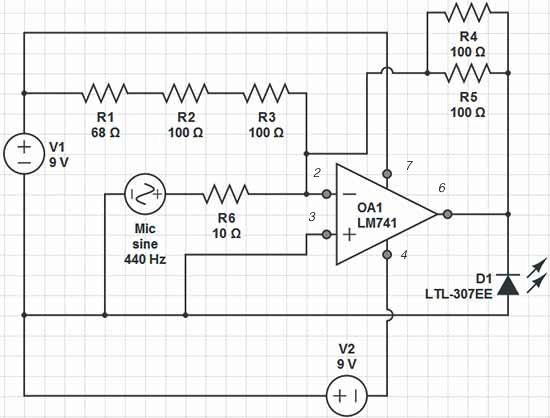
PCM2902 Soundcard with Microphone Input Schematic
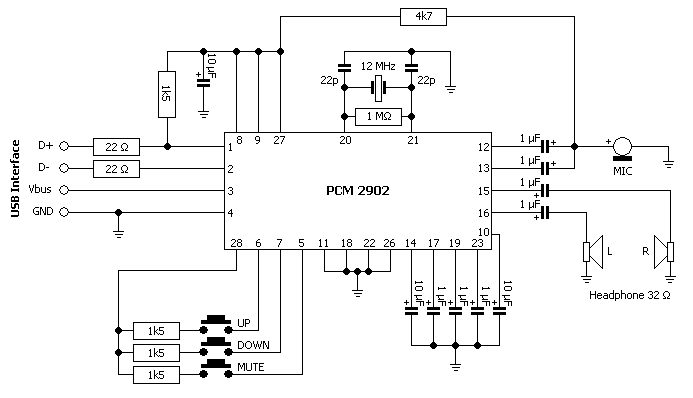
Many individuals use headphones connected to a computer sound card output to enjoy music or games. It is common for these headphones and microphones to connect to the appropriate slots on the sound card. However, if the female plug on the sound card becomes damaged, it can be inconvenient to replace the plug when switching between headphones and speakers. A compact USB sound card can serve as a solution, featuring stereo inputs/outputs, a volume increase button, and a mute button. Upon connection, Windows recognizes it as a sound card. The device is constructed with surface-mount device (SMD) components, allowing it to fit into a small plastic enclosure, which includes a USB cable, audio output for left and right channels, and inputs for condenser microphones. Power is supplied via the USB port. The core integrated circuit is the PCM2902 from Burr-Brown, a Texas Instruments company. This component functions as a stereo 16-bit digital-to-analog converter (DAC) and analog-to-digital converter (ADC), fully compatible with USB 1.1. The DAC supports sampling frequencies of 32, 44.1, and 48 kHz, while the ADC supports 8, 11.025, 16, 22.05, 32, 44.1, and 48 kHz. For increased sound intensity, a TDA 7050 amplifier can be connected to the audio output.
The described USB sound card is a versatile and compact solution for audio input and output needs. Its design incorporates SMD technology, which optimizes space and enhances reliability. The PCM2902 integrated circuit offers high-quality audio processing, making it suitable for both casual listening and professional applications. The inclusion of a volume control and mute button adds user convenience, allowing for quick adjustments without needing to access the computer's software settings.
The power supply through the USB port ensures that the device can be powered by a wide range of computers and laptops, making it highly portable. The stereo inputs and outputs facilitate the connection of various audio devices, including headphones, speakers, and microphones, enabling users to switch seamlessly between different audio sources.
For those seeking enhanced audio performance, the option to integrate the TDA 7050 amplifier provides an effective means to boost audio output. This amplifier is designed to deliver high-quality sound amplification, ensuring that audio playback is clear and powerful. The combination of the PCM2902 and TDA 7050 creates a robust audio solution for users who demand superior sound quality from their computer systems. Overall, this USB sound card serves as an effective and efficient alternative to traditional sound card solutions, particularly in situations where space and functionality are key considerations.Many of us have a pair of headphones connected to the output of the computer sound card us either to enjoy songs, or a game. Very likely your headphones and microphone, which also connect to the appropriate slot your sound card.
But at some point broke down the female plug my sound card, and because quite a lot to change the plug when I put the he adphones and when the speakers. A small structure is a sound card, USB, with stereo inputs / outputs, button to increase / volume button for volume and mute! When connected Windows will recognize as a sound card! With all the materials to be SMD, the cornered enough and fit into a small plastic box, which by one measure has a cable with USB plug, sound to go acoustic (Left / Right) and condenser microphones.
The supply of (as imagined) is done by the USB port. The heart of the integrated circuit is PCM2902 of Burr-Brown by Texas Instruments. It is stereo 16-bit DAC and ADC, fully compatible with USB 1. 1. DAC sampling frequencies are 32, 44. 1 and 48 kHz, ADC has 8, 11. 025, 16, 22. 05, 32, 44. 1 and 48 kHz. If you want more sound intensity, you will need to connect TDA 7050 amplifier to audio output. 🔗 External reference
The described USB sound card is a versatile and compact solution for audio input and output needs. Its design incorporates SMD technology, which optimizes space and enhances reliability. The PCM2902 integrated circuit offers high-quality audio processing, making it suitable for both casual listening and professional applications. The inclusion of a volume control and mute button adds user convenience, allowing for quick adjustments without needing to access the computer's software settings.
The power supply through the USB port ensures that the device can be powered by a wide range of computers and laptops, making it highly portable. The stereo inputs and outputs facilitate the connection of various audio devices, including headphones, speakers, and microphones, enabling users to switch seamlessly between different audio sources.
For those seeking enhanced audio performance, the option to integrate the TDA 7050 amplifier provides an effective means to boost audio output. This amplifier is designed to deliver high-quality sound amplification, ensuring that audio playback is clear and powerful. The combination of the PCM2902 and TDA 7050 creates a robust audio solution for users who demand superior sound quality from their computer systems. Overall, this USB sound card serves as an effective and efficient alternative to traditional sound card solutions, particularly in situations where space and functionality are key considerations.Many of us have a pair of headphones connected to the output of the computer sound card us either to enjoy songs, or a game. Very likely your headphones and microphone, which also connect to the appropriate slot your sound card.
But at some point broke down the female plug my sound card, and because quite a lot to change the plug when I put the he adphones and when the speakers. A small structure is a sound card, USB, with stereo inputs / outputs, button to increase / volume button for volume and mute! When connected Windows will recognize as a sound card! With all the materials to be SMD, the cornered enough and fit into a small plastic box, which by one measure has a cable with USB plug, sound to go acoustic (Left / Right) and condenser microphones.
The supply of (as imagined) is done by the USB port. The heart of the integrated circuit is PCM2902 of Burr-Brown by Texas Instruments. It is stereo 16-bit DAC and ADC, fully compatible with USB 1. 1. DAC sampling frequencies are 32, 44. 1 and 48 kHz, ADC has 8, 11. 025, 16, 22. 05, 32, 44. 1 and 48 kHz. If you want more sound intensity, you will need to connect TDA 7050 amplifier to audio output. 🔗 External reference

